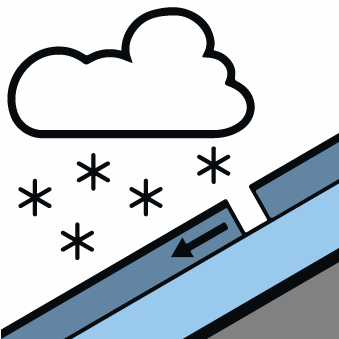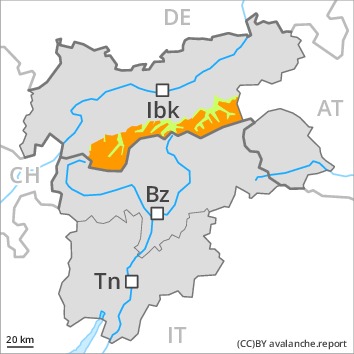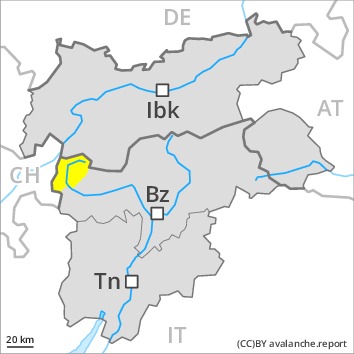
Danger level
 | treeline
|
Avalanche Problem
 | | Wind-drifted snow |
|  | |  |
 | | New snow |
|  | |  |

A precarious avalanche situation will be encountered over a wide area. New snow and wind slabs represent the main danger.
The new snow and wind slabs are prone to triggering in all aspects. Even single backcountry tourers can release avalanches very easily, including medium-sized ones, caution is to be exercised on steep slopes also below the tree line.
Older wind slabs are covered with new snow and therefore difficult to recognise. The avalanche prone locations are widespread, in the regions exposed to a lot of wind in particular in the regions exposed to heavier precipitation and. Whumpfing sounds and the formation of shooting cracks when stepping on the snowpack can indicate the danger. Extensive experience in the assessment of avalanche danger and great restraint are required.
In the regions exposed to heavier precipitation gliding avalanches and snow slides are possible. On extremely steep slopes small and medium-sized loose snow avalanches are possible.
Snowpack
dp.6: cold, loose snow and wind
dp.8: surface hoar blanketed with snow
The new snow and wind slabs are lying on soft layers in all aspects and in all altitude zones. The new snow-covered wind slabs are lying on surface hoar in some places. As a consequence of low temperatures the snowpack can not consolidate.
Towards its base, the snowpack is well consolidated.
Tendency
A sometimes critical avalanche situation will prevail. The weather conditions will prevent a rapid change towards better conditions.

Danger level
 | treeline
|
Avalanche Problem
 | | Wind-drifted snow |
|  | |  |
 | | Persistent weak layer |
|  | |  |

The current avalanche situation calls for experience and restraint.
On wind-loaded slopes a sometimes unfavourable avalanche situation will prevail. The fresh and somewhat older wind slabs can be released by a single winter sport participant in some cases in all aspects. Caution is to be exercised in particular adjacent to ridgelines and in gullies and bowls above the tree line. Mostly the avalanches are medium-sized. The number and size of avalanche prone locations will increase with altitude. In regions exposed to the foehn wind the avalanche prone locations are more prevalent.
Snowpack
dp.6: cold, loose snow and wind
dp.8: surface hoar blanketed with snow
Isolated avalanche prone weak layers exist in the top section of the snowpack at high altitudes and in high Alpine regions. The wind slabs are lying on soft layers. They are lying on surface hoar in some places. Towards its base, the snowpack is well consolidated.
Tendency
Wind slabs are to be evaluated with care and prudence.

Danger level
 | 2200m
|
Avalanche Problem
 | | Persistent weak layer |
|  | |  |
 | | Wind-drifted snow |
|  | |  |

Wind slabs and weakly bonded old snow are to be critically assessed.
Weak layers in the lower part of the snowpack can be released in some places by individual winter sport participants, especially in areas where the snow cover is rather shallow, as well as at transitions from a shallow to a deep snowpack, when entering gullies and bowls for example. This applies in particular on steep shady slopes above approximately 2200 m. In addition the sometimes avalanche prone wind slabs should be taken into account. They can be released by a single winter sport participant especially on steep shady slopes at high altitudes and in high Alpine regions, caution is to be exercised in particular adjacent to ridgelines and in gullies and bowls. In some cases the avalanches are medium-sized.
Snowpack
dp.1: deep persistent weak layer
dp.6: cold, loose snow and wind
The various wind slabs are lying on surface hoar in some places. The wind slabs have bonded poorly with each other and the old snowpack. In some places relatively hard layers of snow are lying on soft layers.
Steep shady slopes: The old snowpack will be prone to triggering in some places. Towards its base, the snowpack consists of faceted crystals.
Tendency
The avalanche danger will persist.

Danger level
 | treeline
|
Avalanche Problem

Wind slabs require caution.
Wind slabs are in some cases prone to triggering above the tree line, especially on very steep shady slopes adjacent to ridgelines. Mostly avalanches are only small but can be released also by a single winter sport participant. The prevalence of avalanche prone locations and likelihood of triggering will increase with altitude.
Snowpack
dp.6: cold, loose snow and wind
In some places wind slabs are lying on soft layers, especially on shady slopes at high altitude. Only a small amount of snow is lying for the time of year.
Tendency
The avalanche danger will persist.

Danger level
 | 2200m
|
Avalanche Problem
 | | Persistent weak layer |
|  | |  |
 | | Wind-drifted snow |
|  | |  |

Wind slabs and weakly bonded old snow require caution.
Weak layers in the lower part of the snowpack can be released especially by large additional loads. This applies in particular on very steep shady slopes above approximately 2200 m, as well as at transitions from a shallow to a deep snowpack, when entering gullies and bowls for example. In some cases the avalanches are medium-sized.
In addition the fresh wind slabs should be taken into account. They can be released by a single winter sport participant especially on steep shady slopes at high altitudes and in high Alpine regions, caution is to be exercised in particular adjacent to ridgelines and in gullies and bowls. The avalanches are rather small.
Snowpack
dp.1: deep persistent weak layer
dp.6: cold, loose snow and wind
In some places various wind slab layers are lying on soft layers. They are lying on surface hoar in some places.
Steep shady slopes high altitudes and the high Alpine regions: Towards its base, the snowpack consists of faceted crystals. The old snowpack will be prone to triggering in some places.
Tendency
The avalanche danger will persist.

Danger level

Low, level 1.
Wind slabs require caution. This applies on very steep shady slopes, and adjacent to ridgelines above approximately 2000 m. The avalanche prone locations are rare and are easy to recognise.
Snowpack
dp.6: cold, loose snow and wind
In some places wind slabs are lying on soft layers, especially on shady slopes at elevated altitudes. From a snow sport perspective, in most cases insufficient snow is lying.
Tendency
Low, level 1.























